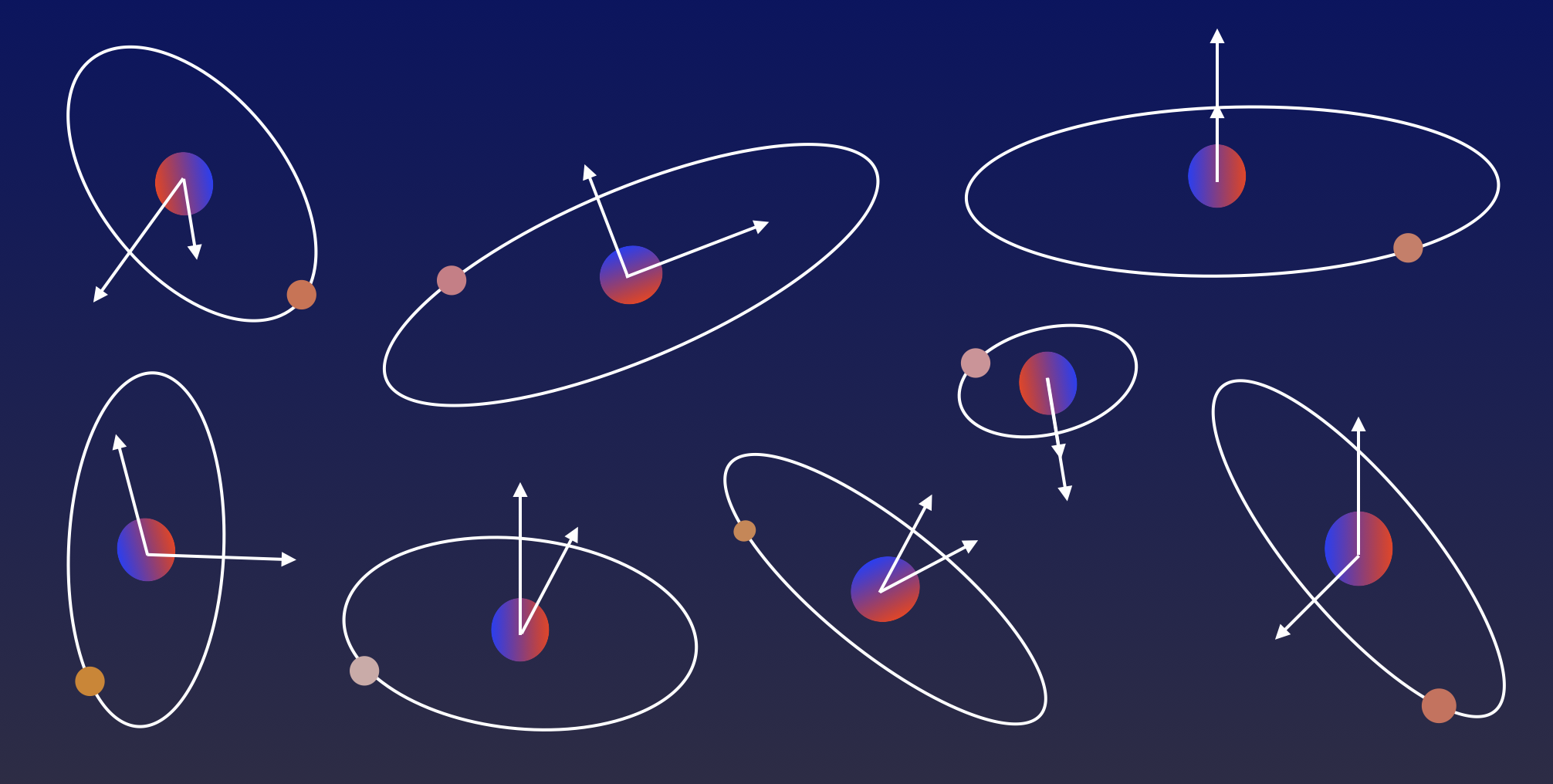Orbital architectures

The geometry of a planetary system — characterized by the orientations and shapes of its constituent orbits, as well as the orientations of its spin vectors — offers a rich set of insights into how that system formed and evolved. Much of my research is driven by studies of planetary system geometries.
One measurable planetary system property that I have examined extensively in my research is the stellar obliquity, or the angle between a star's spin axis and the net orbital angular momentum vector of its surrounding planetary system. While the solar system planets each lie within a few degrees of alignment with the Sun's spin axis, exoplanets have been discovered on retrograde and polar orbits.
I founded and co-lead the Stellar Obliquities in Long-period Exoplanet Systems (SOLES) survey, through which my team measures the obliquities of systems hosting wide-separation planets using the Rossiter-McLaughlin effect. Planets with a relatively large orbital separation from their host star have long tidal realignment timescales and can be used to better understand the underlying, primordial stellar obliquity distribution, with fewer degeneracies than closer-in planets. New measurements from the SOLES survey can also help to disentangle the effect of tidal interactions on the distribution of observed hot Jupiter spin-orbit angles. I have worked to characterize hot and warm Jupiter formation mechanisms through population studies of exoplanet spin-orbit angles.
Recently, I demonstrated that the stellar obliquity distribution provides tantalizing hints consistent with high-eccentricity migration as the key hot Jupiter formation mechanism. Read my associated research highlight here.
In my research highlight here, I demonstrate an observed tendency toward alignment in single-star warm Jupiter systems, and I describe the implications of this finding for hot and warm Jupiter formation.
The eighth result from the SOLES survey demonstrates that near-resonant systems are generally consistent with a quiescent formation pathway, with some room for low-level protoplanetary disk misalignments or post-disk-dispersal spin-orbit excitation. Read more in the research highlight here.
Select associated publications
- Rusznak, J., Wang, X.-Y., Rice, M., & Wang, S. 2025 ApJL 983, L42 - From Misaligned Sub-Saturns to Aligned Brown Dwarfs: The Highest Mp/M* Systems Exhibit Low Obliquities, Even around Hot Stars
- Faridani, T., Naoz, S., Li, G., Rice, M., & Inzunza, N. 2024 ApJ 978, 18 - More Likely Than You Think: Inclination-Driving Secular Resonances are Common in Known Exoplanet Systems
- Wang, X.-Y., Rice, M., Wang, S., et al. 2024 ApJL 973, L21 - Single-star Warm-Jupiter Systems Tend to Be Aligned, Even around Hot Stellar Hosts: No Teff–λ Dependency
- Ferreira dos Santos, T., Rice, M., Wang, X.-Y., & Wang, S. 2024 AJ 168, 145 - SOLES XII. The Aligned Orbit of TOI-2533 b, a Transiting Brown Dwarf Orbiting an F8-type Star
- Radzom, B.T., Dong, J., Rice, M., et al. 2024 AJ 168, 116 - Evidence for Primordial Alignment: Insights from Stellar Obliquity Measurements for Compact Sub-Saturn Systems
- Hu, Q., Rice, M., Wang, X.-Y., et al. 2024 AJ 167, 175 - The PFS View of TOI-677 b: A Spin-Orbit Aligned Warm Jupiter in a Dynamically Hot System
- Rice, M., Wang, X.-Y., Wang, S., et al. 2023 AJ 166, 266 - Evidence for Low-Level Dynamical Excitation in Near-Resonant Exoplanet Systems
- Wu, D.-H., Rice, M., & Wang, S. 2023 AJ 165, 171 - Evidence for Hidden Nearby Companions to Hot Jupiters
- Rice, M., Wang, S., Wang, X.-Y., et al. 2022 AJ 164, 104 - A Tendency Toward Alignment in Single-Star Warm-Jupiter Systems
- Rice, M., Wang, S., & Laughlin, G. 2022 ApJL 926, L17 - Origins of Hot Jupiters from the Stellar Obliquity Distribution
- Wang, X.-Y., Rice, M., Wang, S., et al. 2022 ApJL 926, L8 - The Aligned Orbit of WASP-148b, the Only Known Hot Jupiter with a Nearby Warm Jupiter Companion, from NEID and HIRES
- Rice, M., Wang, S., Howard, A., et al. 2021 AJ 162, 182 - SOLES I: The Spin-Orbit Alignment of K2-140 b